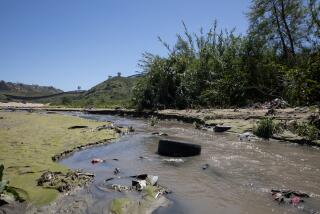UCSD Scientists Say Area Could Be Living Lab to Study Water Woes
A group of UC San Diego scientists believes that San Diego’s climate, chronic water pollution and shortage of fresh water constitute the perfect “natural laboratory” for developing experimental technology needed to solve the region’s future water woes.
The 24 academics, led by a Scripps Institute of Oceanography research biologist and a UCSD water mechanics specialist, are proposing that the university establish an interdisciplinary Center for Water Research and are competing with 600 other groups from around the country for 10 multimillion-dollar grants being handed out by the National Science Foundation next year.
Wide-Ranging Research
Their research will explore everything from improved methods of reclaiming waste water to better desalination technology and more efficient ways of spraying water on crops, said Mark Huntley, the Scripps biologist, and Hassan Aref, the water engineer.
“Right now there isn’t the pressing forward of research in this area that’s needed, because people are running around (battling current problems),” Huntley said. For example, the City of San Diego, which is spending millions of dollars to stop frequent sewage spills into Mission Bay, could instead benefit from research efforts aimed at finding ways to clean up and re-use waste water, he said.
San Diego’s natural and man-made characteristics make it an ideal site for a water research center, Huntley said. “Here, we have an excellent laboratory for water problems. We have ground water aquifers that are contaminated. We have an abundance of solar energy and we are an arid region with water (shortage) problems,” he said.
Solution Close at Hand
In the city’s primary aqueous asset--the Pacific Ocean--lie potential solutions to the shortage of fresh water, and pollution problems that must be addressed, Huntley and Aref noted. Scientists cannot afford to ignore that a significant portion of that pollution comes from beyond the border, where Tijuana’s defective sewer-treatment facility is pouring 20 million gallons of untreated waste into the Pacific daily.
“San Diego can do whatever we want to clean up our act, but then we still have 20 million gallons of raw sewage coming out of Tijuana,” Huntley said.
To that end, the scientists hope to make the center a clearinghouse for technology transfer to Mexico and other parts of the United States, and train students in an interdisciplinary approach to water-resource management.
Other proposed research projects include:
- Adding polymers to water sprayed on crops to create bigger droplets and reduce the loss of water through evaporation.
- Introducing flatworms that eat mosquito larvae to control mosquito breeding in water hyacinth ponds, which are being used experimentally by the city of San Diego to help filter fine solids from sewage.
- Genetically engineering bacteria to enable them to absorb metals from industrial waste water.
- Finding ways to improve purification and transportation of water used in manufacturing microchips.
More to Read
Sign up for Essential California
The most important California stories and recommendations in your inbox every morning.
You may occasionally receive promotional content from the Los Angeles Times.










